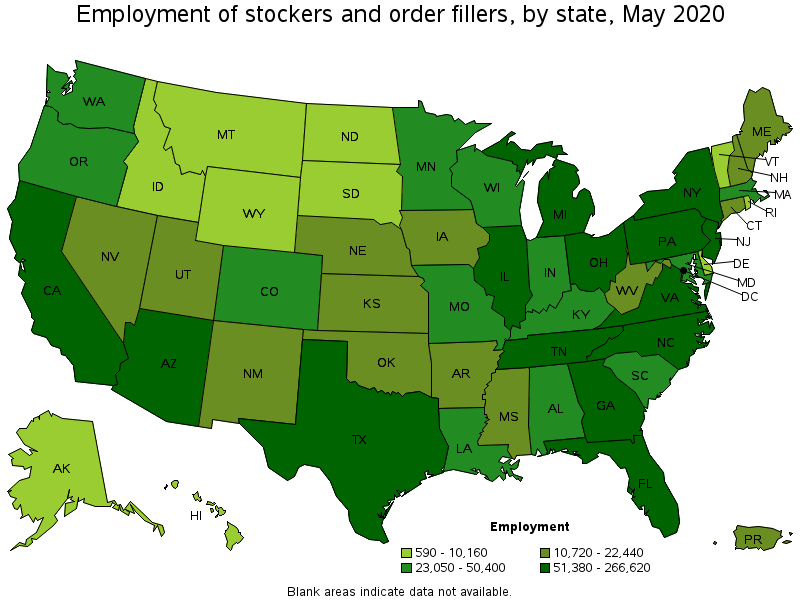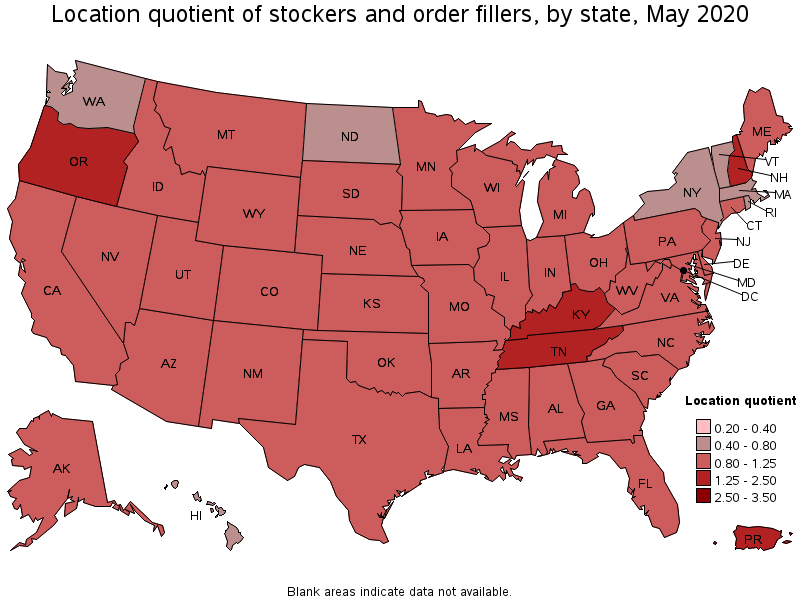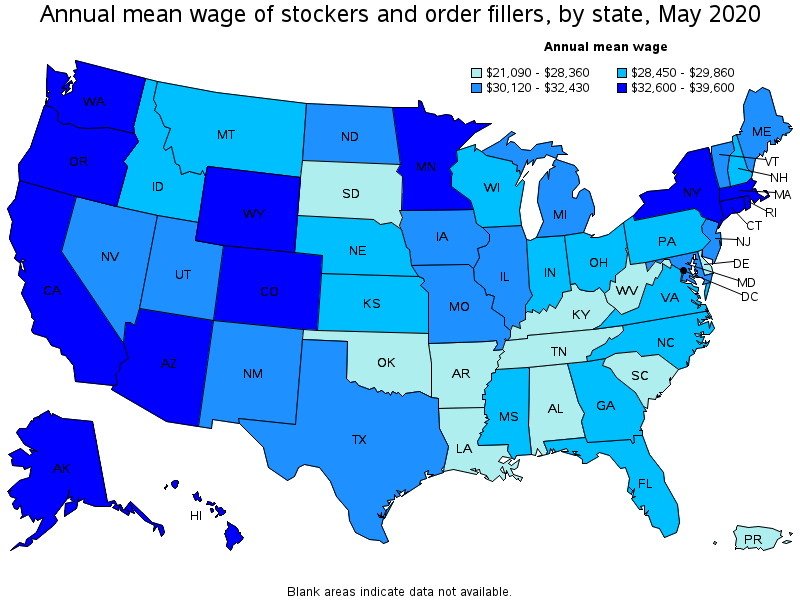An official website of the United States government
 United States Department of Labor
United States Department of Labor
Receive, store, and issue merchandise, materials, equipment, and other items from stockroom, warehouse, or storage yard to fill shelves, racks, tables, or customers' orders. May operate power equipment to fill orders. May mark prices on merchandise and set up sales displays. Excludes "Shipping, Receiving, and Inventory Clerks" (43-5071), "Laborers and Freight, Stock, and Material Movers, Hand" (53-7062), and "Packers and Packagers, Hand" (53-7064).
Employment estimate and mean wage estimates for Stockers and Order Fillers:
| Employment (1) | Employment RSE (3) |
Mean hourly wage |
Mean annual wage (2) |
Wage RSE (3) |
|---|---|---|---|---|
| 2,210,960 | 0.8 % | $ 14.91 | $ 31,010 | 0.2 % |
Percentile wage estimates for Stockers and Order Fillers:
| Percentile | 10% | 25% | 50% (Median) |
75% | 90% |
|---|---|---|---|---|---|
| Hourly Wage | $ 10.29 | $ 11.96 | $ 14.03 | $ 17.06 | $ 20.64 |
| Annual Wage (2) | $ 21,410 | $ 24,870 | $ 29,190 | $ 35,490 | $ 42,930 |
Industries with the highest published employment and wages for Stockers and Order Fillers are provided. For a list of all industries with employment in Stockers and Order Fillers, see the Create Customized Tables function.
Industries with the highest levels of employment in Stockers and Order Fillers:
| Industry | Employment (1) | Percent of industry employment | Hourly mean wage | Annual mean wage (2) |
|---|---|---|---|---|
| General Merchandise Stores | 563,430 | 18.82 | $ 13.42 | $ 27,920 |
| Food and Beverage Stores (4451 and 4452 only) | 559,410 | 19.24 | $ 14.04 | $ 29,200 |
| Warehousing and Storage | 270,440 | 19.07 | $ 17.04 | $ 35,440 |
| Building Material and Supplies Dealers | 105,540 | 9.12 | $ 14.24 | $ 29,630 |
| Merchant Wholesalers, Nondurable Goods (4244 and 4248 only) | 76,710 | 8.10 | $ 16.65 | $ 34,620 |
Industries with the highest concentration of employment in Stockers and Order Fillers:
| Industry | Employment (1) | Percent of industry employment | Hourly mean wage | Annual mean wage (2) |
|---|---|---|---|---|
| Food and Beverage Stores (4451 and 4452 only) | 559,410 | 19.24 | $ 14.04 | $ 29,200 |
| Warehousing and Storage | 270,440 | 19.07 | $ 17.04 | $ 35,440 |
| General Merchandise Stores | 563,430 | 18.82 | $ 13.42 | $ 27,920 |
| Building Material and Supplies Dealers | 105,540 | 9.12 | $ 14.24 | $ 29,630 |
| Merchant Wholesalers, Nondurable Goods (4244 and 4248 only) | 76,710 | 8.10 | $ 16.65 | $ 34,620 |
Top paying industries for Stockers and Order Fillers:
| Industry | Employment (1) | Percent of industry employment | Hourly mean wage | Annual mean wage (2) |
|---|---|---|---|---|
| Natural Gas Distribution | 400 | 0.37 | $ 32.84 | $ 68,300 |
| Postal Service (federal government) | 440 | 0.07 | $ 30.62 | $ 63,690 |
| Electric Power Generation, Transmission and Distribution | 2,100 | 0.55 | $ 26.17 | $ 54,440 |
| Tobacco Manufacturing | 170 | 1.68 | $ 23.89 | $ 49,690 |
| Scheduled Air Transportation | 4,140 | 0.94 | $ 23.56 | $ 49,010 |
States and areas with the highest published employment, location quotients, and wages for Stockers and Order Fillers are provided. For a list of all areas with employment in Stockers and Order Fillers, see the Create Customized Tables function.

States with the highest employment level in Stockers and Order Fillers:
| State | Employment (1) | Employment per thousand jobs | Location quotient (9) | Hourly mean wage | Annual mean wage (2) |
|---|---|---|---|---|---|
| California | 266,620 | 16.23 | 1.02 | $ 16.56 | $ 34,450 |
| Texas | 194,230 | 16.05 | 1.01 | $ 14.63 | $ 30,440 |
| Florida | 152,200 | 18.03 | 1.13 | $ 14.00 | $ 29,120 |
| New York | 105,740 | 12.17 | 0.77 | $ 15.67 | $ 32,600 |
| Pennsylvania | 97,090 | 17.61 | 1.11 | $ 14.01 | $ 29,140 |

States with the highest concentration of jobs and location quotients in Stockers and Order Fillers:
| State | Employment (1) | Employment per thousand jobs | Location quotient (9) | Hourly mean wage | Annual mean wage (2) |
|---|---|---|---|---|---|
| New Hampshire | 14,020 | 22.63 | 1.42 | $ 14.35 | $ 29,860 |
| Oregon | 38,250 | 21.17 | 1.33 | $ 16.37 | $ 34,050 |
| Tennessee | 59,940 | 20.64 | 1.30 | $ 13.60 | $ 28,290 |
| Kentucky | 35,950 | 20.17 | 1.27 | $ 13.59 | $ 28,260 |
| Mississippi | 20,540 | 19.07 | 1.20 | $ 13.68 | $ 28,450 |

Top paying states for Stockers and Order Fillers:
| State | Employment (1) | Employment per thousand jobs | Location quotient (9) | Hourly mean wage | Annual mean wage (2) |
|---|---|---|---|---|---|
| District of Columbia | 2,540 | 3.70 | 0.23 | $ 19.04 | $ 39,600 |
| Washington | 34,420 | 10.77 | 0.68 | $ 17.80 | $ 37,030 |
| Alaska | 4,700 | 15.85 | 1.00 | $ 17.06 | $ 35,480 |
| Massachusetts | 40,700 | 12.15 | 0.76 | $ 16.60 | $ 34,530 |
| California | 266,620 | 16.23 | 1.02 | $ 16.56 | $ 34,450 |

Metropolitan areas with the highest employment level in Stockers and Order Fillers:
| Metropolitan area | Employment (1) | Employment per thousand jobs | Location quotient (9) | Hourly mean wage | Annual mean wage (2) |
|---|---|---|---|---|---|
| New York-Newark-Jersey City, NY-NJ-PA | 114,730 | 12.99 | 0.82 | $ 15.66 | $ 32,580 |
| Los Angeles-Long Beach-Anaheim, CA | 79,310 | 13.62 | 0.86 | $ 16.34 | $ 33,990 |
| Dallas-Fort Worth-Arlington, TX | 62,860 | 17.52 | 1.10 | $ 15.47 | $ 32,180 |
| Chicago-Naperville-Elgin, IL-IN-WI | 59,600 | 13.66 | 0.86 | $ 15.32 | $ 31,870 |
| Riverside-San Bernardino-Ontario, CA | 57,780 | 38.79 | 2.44 | $ 16.44 | $ 34,200 |
| Houston-The Woodlands-Sugar Land, TX | 49,680 | 16.73 | 1.05 | $ 14.44 | $ 30,030 |
| Miami-Fort Lauderdale-West Palm Beach, FL | 45,100 | 17.98 | 1.13 | $ 13.69 | $ 28,480 |
| Philadelphia-Camden-Wilmington, PA-NJ-DE-MD | 40,670 | 15.08 | 0.95 | $ 14.41 | $ 29,970 |
| Phoenix-Mesa-Scottsdale, AZ | 40,140 | 19.04 | 1.20 | $ 16.23 | $ 33,770 |
| Atlanta-Sandy Springs-Roswell, GA | 37,220 | 14.14 | 0.89 | $ 14.10 | $ 29,320 |

Metropolitan areas with the highest concentration of jobs and location quotients in Stockers and Order Fillers:
| Metropolitan area | Employment (1) | Employment per thousand jobs | Location quotient (9) | Hourly mean wage | Annual mean wage (2) |
|---|---|---|---|---|---|
| Riverside-San Bernardino-Ontario, CA | 57,780 | 38.79 | 2.44 | $ 16.44 | $ 34,200 |
| Cheyenne, WY | 1,610 | 35.85 | 2.26 | $ 17.20 | $ 35,770 |
| Lancaster, PA | 7,910 | 34.02 | 2.14 | $ 14.75 | $ 30,690 |
| Scranton--Wilkes-Barre--Hazleton, PA | 7,990 | 32.97 | 2.07 | $ 14.32 | $ 29,780 |
| Danville, IL | 820 | 32.53 | 2.05 | $ 15.55 | $ 32,340 |
| Harrisonburg, VA | 1,970 | 31.88 | 2.01 | $ 14.62 | $ 30,410 |
| Albany, OR | 1,340 | 31.28 | 1.97 | $ 16.27 | $ 33,830 |
| Harrisburg-Carlisle, PA | 8,680 | 27.86 | 1.75 | $ 14.10 | $ 29,320 |
| Jackson, MI | 1,250 | 26.97 | 1.70 | $ 14.77 | $ 30,730 |
| Elmira, NY | 840 | 26.59 | 1.67 | $ 14.56 | $ 30,280 |

Top paying metropolitan areas for Stockers and Order Fillers:
| Metropolitan area | Employment (1) | Employment per thousand jobs | Location quotient (9) | Hourly mean wage | Annual mean wage (2) |
|---|---|---|---|---|---|
| Odessa, TX | 1,360 | 18.51 | 1.16 | $ 18.81 | $ 39,130 |
| Seattle-Tacoma-Bellevue, WA | 17,960 | 9.19 | 0.58 | $ 18.77 | $ 39,040 |
| San Jose-Sunnyvale-Santa Clara, CA | 8,250 | 7.48 | 0.47 | $ 18.55 | $ 38,580 |
| Napa, CA | 830 | 11.97 | 0.75 | $ 18.43 | $ 38,340 |
| Hanford-Corcoran, CA | 410 | 9.56 | 0.60 | $ 18.38 | $ 38,230 |
| San Francisco-Oakland-Hayward, CA | 26,460 | 11.35 | 0.71 | $ 18.28 | $ 38,020 |
| Fairbanks, AK | 770 | 24.80 | 1.56 | $ 18.12 | $ 37,680 |
| Yakima, WA | 1,340 | 14.85 | 0.93 | $ 17.78 | $ 36,980 |
| Weirton-Steubenville, WV-OH | 770 | 21.96 | 1.38 | $ 17.68 | $ 36,770 |
| Mount Vernon-Anacortes, WA | 530 | 11.45 | 0.72 | $ 17.62 | $ 36,650 |
Nonmetropolitan areas with the highest employment in Stockers and Order Fillers:
| Nonmetropolitan area | Employment (1) | Employment per thousand jobs | Location quotient (9) | Hourly mean wage | Annual mean wage (2) |
|---|---|---|---|---|---|
| North Texas Region of Texas nonmetropolitan area | 5,390 | 20.03 | 1.26 | $ 13.94 | $ 29,000 |
| South Central Kentucky nonmetropolitan area | 5,240 | 32.96 | 2.07 | $ 12.47 | $ 25,930 |
| West Northwestern Ohio nonmetropolitan area | 4,750 | 19.89 | 1.25 | $ 13.70 | $ 28,500 |
| Southern Pennsylvania nonmetropolitan area | 4,660 | 25.86 | 1.63 | $ 15.26 | $ 31,750 |
| Kansas nonmetropolitan area | 4,640 | 12.27 | 0.77 | $ 13.52 | $ 28,120 |
Nonmetropolitan areas with the highest concentration of jobs and location quotients in Stockers and Order Fillers:
| Nonmetropolitan area | Employment (1) | Employment per thousand jobs | Location quotient (9) | Hourly mean wage | Annual mean wage (2) |
|---|---|---|---|---|---|
| South Central Kentucky nonmetropolitan area | 5,240 | 32.96 | 2.07 | $ 12.47 | $ 25,930 |
| Northeast Lower Peninsula of Michigan nonmetropolitan area | 1,850 | 27.64 | 1.74 | $ 13.08 | $ 27,210 |
| Southern Pennsylvania nonmetropolitan area | 4,660 | 25.86 | 1.63 | $ 15.26 | $ 31,750 |
| Northeast Coastal North Carolina nonmetropolitan area | 2,280 | 25.57 | 1.61 | $ 14.07 | $ 29,270 |
| Southwest Iowa nonmetropolitan area | 1,950 | 24.56 | 1.55 | $ 16.17 | $ 33,630 |
Top paying nonmetropolitan areas for Stockers and Order Fillers:
| Nonmetropolitan area | Employment (1) | Employment per thousand jobs | Location quotient (9) | Hourly mean wage | Annual mean wage (2) |
|---|---|---|---|---|---|
| Northwest Colorado nonmetropolitan area | 1,630 | 14.23 | 0.90 | $ 17.02 | $ 35,410 |
| Western Wyoming nonmetropolitan area | 870 | 9.24 | 0.58 | $ 16.82 | $ 34,990 |
| Western Washington nonmetropolitan area | 1,820 | 15.46 | 0.97 | $ 16.77 | $ 34,880 |
| Southeast Minnesota nonmetropolitan area | 2,260 | 15.25 | 0.96 | $ 16.60 | $ 34,520 |
| Western Wisconsin nonmetropolitan area | 2,310 | 17.38 | 1.09 | $ 16.55 | $ 34,420 |
These estimates are calculated with data collected from employers in all industry sectors, all metropolitan and nonmetropolitan areas, and all states and the District of Columbia. The top employment and wage figures are provided above. The complete list is available in the downloadable XLS files.
The percentile wage estimate is the value of a wage below which a certain percent of workers fall. The median wage is the 50th percentile wage estimate—50 percent of workers earn less than the median and 50 percent of workers earn more than the median. More about percentile wages.
(1) Estimates for detailed occupations do not sum to the totals because the totals include occupations not shown separately. Estimates do not include self-employed workers.
(2) Annual wages have been calculated by multiplying the hourly mean wage by a "year-round, full-time" hours figure of 2,080 hours; for those occupations where there is not an hourly wage published, the annual wage has been directly calculated from the reported survey data.
(3) The relative standard error (RSE) is a measure of the reliability of a survey statistic. The smaller the relative standard error, the more precise the estimate.
(9) The location quotient is the ratio of the area concentration of occupational employment to the national average concentration. A location quotient greater than one indicates the occupation has a higher share of employment than average, and a location quotient less than one indicates the occupation is less prevalent in the area than average.
Other OEWS estimates and related information:
May 2020 National Occupational Employment and Wage Estimates
May 2020 State Occupational Employment and Wage Estimates
May 2020 Metropolitan and Nonmetropolitan Area Occupational Employment and Wage Estimates
May 2020 National Industry-Specific Occupational Employment and Wage Estimates
Last Modified Date: March 31, 2021